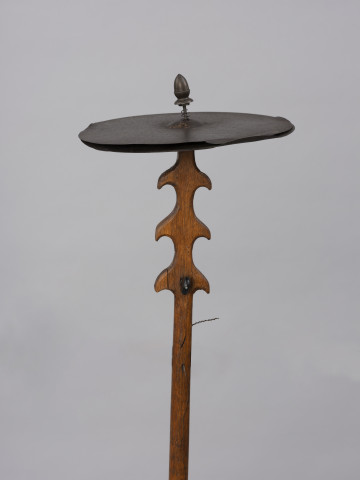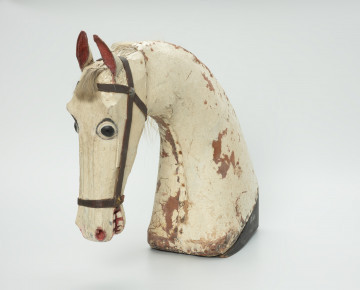
Bladder fiddle (Deil's fiddle)
1901 — 1945
National Museum in Szczecin
Part of the collection: Material culture of West Pomerania
Around Christmas time in Pomeranian villages, one could encounter groups of masqueraders, going from one household to another, performing ritual scenes and wishing the inhabitants good luck. This custom continued in Pomerania until the first half of the 20th century. The main characters in the scenes played by the masqueraders were animal monstrosities. One of the most common creatures in Central Pomerania was a goat, symbolising fertility and vitality. Its role was played by a boy covered with a cloth sheet or wearing a sheepskin turned inside out. In his hands, he would hold a stick topped with a wooden goat's head on it, often with its jaw moved by a string. Both the appearance of the creature and its actions had a deep symbolic meaning, and its entire performance followed a predetermined script. First, the goat was led into the house on a rope, and when it got inside the room it started to dance, snap its snout, frighten children, and tease girls with its horns. At a key moment, the frisky goat would fall dead to the ground and then be brought back to life by one of the accompanying characters. The death and resurrection of the goat symbolised nature's winter sleep and its return to life in spring, and the ritual itself was linked to magical thinking according to which “like produces like”. There are three ceremonial goat masks in the collection of the Department of Ethnography of Pomerania of the National Museum in Szczecin. The early 20th-century mask presented here is made from a single piece of wood that has been shaped to resemble an animal head. It is painted white. Ears made of leather and long, curved and stripped of bark sticks representing horns were attached to the head with nails. There are also traces of red paint on the snout.
Agnieszka Słowińska
Author / creator
Dimensions
cały obiekt: height: 7 cm, width: 26,5 cm
Creation time / dating
Creation / finding place
Identification number
Location / status

1901 — 1945
National Museum in Szczecin

1. połowa XX wieku
National Museum in Szczecin

1. połowa XX wieku
National Museum in Szczecin
DISCOVER this TOPIC
National Museum in Szczecin
DISCOVER this PATH
Educational path